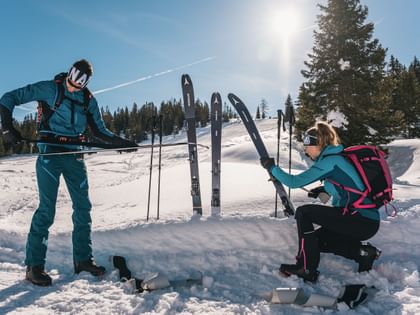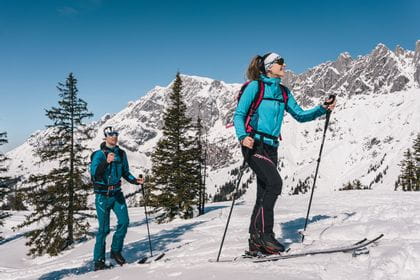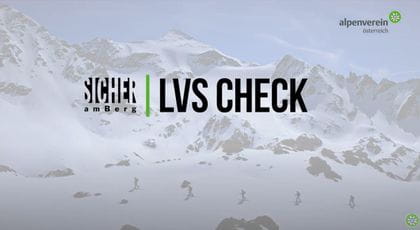Ski touring made easy
Tips and tricks for you and the mountain
A once-in-a-lifetime nature experience, far removed from the bustling slopes & après-ski, combined with a downhill ride plucked from the pages of a picture book, certain to set your pulse racing in pure anticipation. There’s good reason ski touring is growing more and more popular! A white blanket of virgin snow glistening in the sunshine combined with the silence of nature draws increasing numbers of sports fans into the mountains. Have we now whetted your appetite, too?
Allow us this opportunity to share a few useful tips & tricks, so that nothing more stands in the way of your first ski tour and an extraordinary mountain adventure.

1. Weather Forecast & Current Conditions
So, do you have your new ski-touring equipment and now you are raring to go? In that case, before setting out, be sure to check the local weather forecast and current avalanche conditions in the area. The avalanche report provides you with a detailed overview of current risk situations affecting your region and tour. But also be aware, even that doesn’t give you a free pass. For example, an avalanche safety course makes a whole lot of sense if you want to mitigate the risks whenever you go off-piste.
2. What to pack in my rucksack
Is your rucksack already full? If so, doublecheck to ensure you can check off all of the following:
- Avalanche probe and shovel, avalanche transponder – on your body
- First-aid kit including bivy sack
- Helmet & ski glasses
- Change of clothing
- Ski crampons
- Provisions
- Plenty to drink
- Sun protection
- Ski skins
Also make sure you distribute items correctly inside your rucksack, which will save you energy during the climb. Ideally, the rucksack will have a 20 to 30 l capacity, with heavier objects stowed close to your back, lighter ones more towards the outside of the rucksack.

3. Getting Started
Be quite clear, no skins equals no climb. Doublecheck that you have attached the skins to your skis correctly. Are your bindings in walk mode, as are your boots? If so, you are ready to go, almost. Turn on your avalanche transponder (to “transmit”), check that it’s working correctly with the rest of your group, and then you will finally be able to set out.
4. Master your techniques
If you feel fit and ready, then it’s time to head out! To get started, choose a tour that matches your physical condition and abilities. At the beginning, the fringe of a piste might be all you need to develop a keen sense for the motion and intensity of this sport. Sharp turns can be practiced in flat terrain, so you don’t encounter unexpected surprises if things get “serious”. Experienced guides can take a look at your technique and help you quickly correct any minor beginners’ mistakes you might be making.


5. Der Aufstieg
Beim Aufstieg ist es wichtig deinen persönlichen Rhythmus zu finden und diesen beizubehalten. Zu schnelles Losgehen lässt später grüßen! Geht dir die Energie aus, ist es ratsam immer wieder Pausen einzulegen und genug zu trinken. Das Naturerlebnis kann durch das Innehalten auch viel besser aufgenommen werden. Bist du schließlich oben angekommen, ist es noch nicht ganz geschafft! Der Lohn für die Anstrengung wartet noch auf dich. Leg eine Pause ein, hol deinen Proviant aus dem Rucksack, wechsle deine Kleidung und sammle Kraft für die Abfahrt.
6. Das Beste kommt zum Schluss
Bevor es losgeht sind noch einige Schritte zu beachten! Sind die Schuhe im Abfahrtsmodus und die Bindung ist umgestellt? Die Felle hast du im Idealfall auf die Folie geklebt und trocken verstaut, falls du nochmals aufsteigen möchtest. Die Abfahrt im Gelände startet ihr als Kleingruppe besser einzeln & wartet in Sichtweite aufeinander. Der Rest sollte dann purer Genuss sein, mit einer kleinen Einschränkung. Nimm Rücksicht auf Wildtiere, respektiere Schutzgebiete und betrete keine Aufforstungsflächen.

Success!
You have now completed your very first ski tour! Before planning the next one, take good care of your gear once you get home. Store your skins and skis in a nice dry place, ensuring they bring you more joy for a long time to come. Important: Don’t place the skins directly on heaters since this might cause the adhesive to separate.
Skitouring Hightlights
Ski touring ski, shoes and ski touring sets
Our employees in our shops will be happy to help you find the equipment that’s perfect for you!

